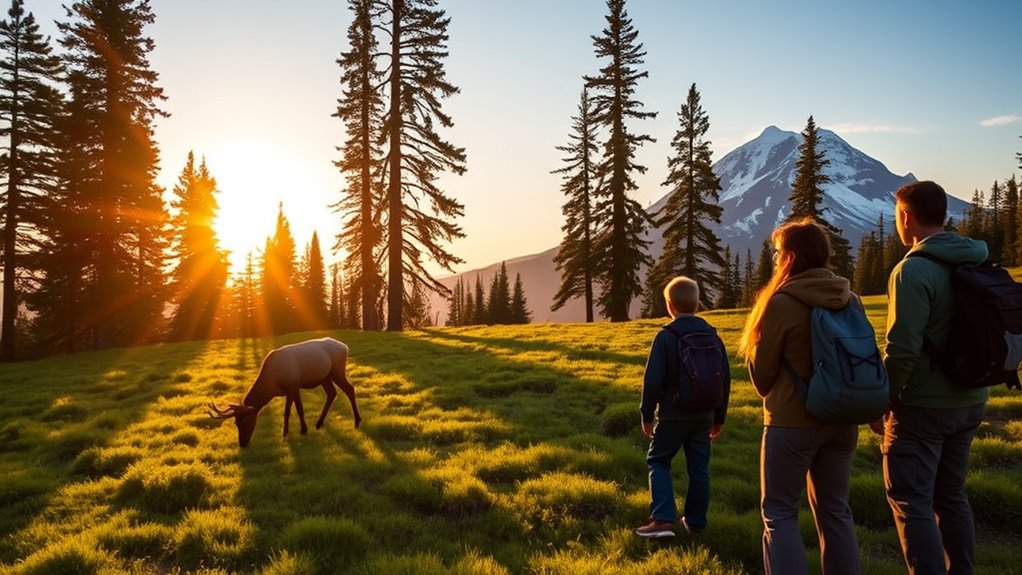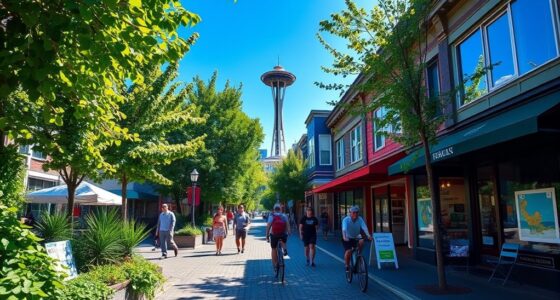When watching wildlife in Glacier National Park, always stay at least 100 yards from bears and wolves, and 25 yards from other animals. Use binoculars for a closer look, and avoid flash photography. Keep noise to a minimum and travel in groups for safety. Never feed wildlife, stick to marked trails, and respect their space. By following these guidelines, you’ll help safeguard their habitat and ensure a positive experience for everyone. There’s plenty more to discover about wildlife etiquette!
Key Takeaways
- Maintain at least 100 yards distance from bears and wolves, and 25 yards from other wildlife like deer and moose.
- Use binoculars or zoom lenses for photography to avoid disturbing animals in their natural habitat.
- Carry bear spray and know how to use it; travel in groups and make noise to alert wildlife during hikes.
- Never feed wildlife and stay on established trails to minimize environmental impact and protect the ecosystem.
- Respect animals’ natural behavior and contribute to conservation by following all wildlife viewing guidelines and etiquette.

When you step into Glacier National Park, you enter a world teeming with diverse wildlife, but respecting these creatures and their habitat is crucial. The park is home to various species, from majestic elk to elusive bears, and it’s your responsibility to guarantee their safety and yours. Observing wildlife in their natural habitat can be thrilling, but it comes with the need for thoughtful etiquette.
First, always keep a safe distance. Approaching wildlife too closely can cause stress for the animals and put you in danger. A general rule is to stay at least 100 yards away from bears and wolves, and 25 yards from other animals like deer and moose. Using binoculars or a zoom lens for photography helps you capture stunning images without encroaching on their space. This brings us to the importance of having good photography tips in mind. When you’re out in the field, make sure your camera settings are adjusted for the lighting conditions, and remember to respect the wildlife by avoiding flash photography. It can startle animals and disrupt their natural behavior.
Always maintain a safe distance from wildlife, using binoculars or zoom lenses for photography to respect their space.
Before you venture out, familiarize yourself with safety precautions. Carry bear spray, know how to use it, and make noise while hiking to alert any nearby wildlife of your presence. It’s also wise to travel in groups, as there’s safety in numbers. If you encounter an animal on the trail, give it the right-of-way, and back away slowly if they approach. Never feed wildlife, as it can lead to aggressive behavior and ultimately harm both the animals and visitors.
Additionally, be mindful of your surroundings. Observe the signs of wildlife activity, such as tracks or droppings, and stay aware of any changes in the environment. If you’re in a designated viewing area, remain on established trails to minimize your impact on the habitat. These small actions can considerably help protect the delicate ecosystem. Remember that professional results in a home setting can be achieved with the right tools, just as photographers use equipment to capture the beauty of nature responsibly.
As you enjoy your wildlife viewing experience, remember that the beauty of Glacier National Park lies in its wildness. By adhering to these etiquette guidelines, you’ll not only enhance your own experience but also play a crucial role in preserving the park for future generations. So, grab your camera, respect the distance, and immerse yourself in the stunning wilderness that surrounds you.
Frequently Asked Questions
What Types of Wildlife Can I Expect to See in Glacier National Park?
In Glacier National Park, you can expect to see a rich wildlife diversity, including grizzly bears, moose, bighorn sheep, and various bird species. As you explore, observe these animals’ behaviors, like a bear foraging or a moose grazing near a pond. Keep your distance to enjoy their natural antics safely. Each encounter offers a unique glimpse into the park’s vibrant ecosystem, so stay alert and appreciate the beauty around you.
Are There Any Specific Seasons Best for Wildlife Viewing?
Sure, if you’re aiming to see wildlife while ignoring the signs of nature, you might just miss the best viewing seasons! Spring and early summer are prime times when animals are active, frolicking about as if they’re in a wildlife parade. Fall’s also great, as critters prepare for winter, showcasing their seasonal wildlife activity. So, grab your binoculars and enjoy the show, while respecting their space, of course!
Can I Bring My Pet While Viewing Wildlife?
You can’t bring your pet while viewing wildlife in the park. For pet safety and the well-being of wildlife, park regulations strictly prohibit pets on trails and in many areas. This helps prevent stressful encounters for both animals and visitors. If you’re traveling with a pet, consider alternative arrangements, like finding a pet sitter or a kennel nearby. Always prioritize safety and respect for the park’s natural inhabitants during your visit.
What Should I Do if I Encounter a Bear?
If you encounter a bear, it’s like stumbling upon a storm in the woods—startling and powerful. Stay calm, back away slowly, and maintain a proper distance. Don’t run; instead, talk to the bear in a firm voice to let it know you’re human. Remember, bear safety is essential. If the bear approaches, make yourself look bigger and make noise, but never put yourself between a mother and her cubs.
Are There Guided Tours Available for Wildlife Viewing?
Yes, there are guided tour options available for wildlife viewing. These tours often include knowledgeable guides who can enhance your experience by sharing insights about the local wildlife. Wildlife tour costs vary depending on the duration and group size, but you can generally expect to pay between $50 to $150 per person. It’s a great way to safely explore the area and increase your chances of spotting animals in their natural habitat.
Conclusion
As you wander through Glacier National Park, remember that every encounter with wildlife is a fleeting moment in nature’s grand tapestry. Treat these majestic creatures with respect, keeping your distance like a shadow in the woods. By following proper etiquette, you’re not just preserving their habitat; you’re weaving a bond with the wilderness itself. So, tread lightly, listen closely, and let the echoes of your adventure resonate through the ages, ensuring that these wonders remain for generations to come.










